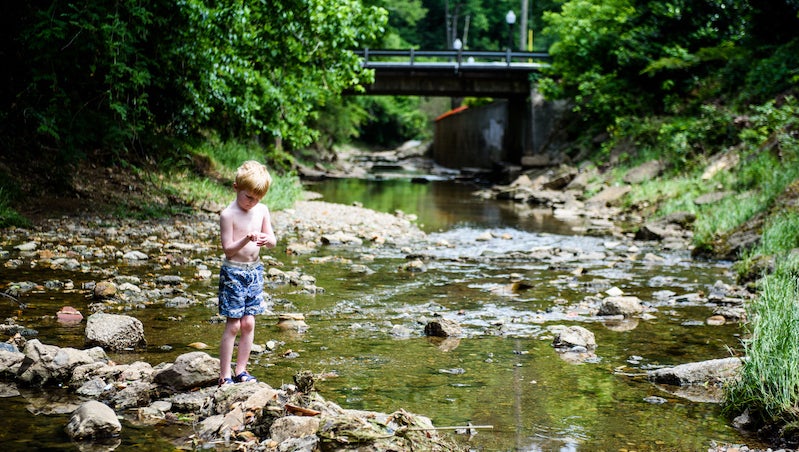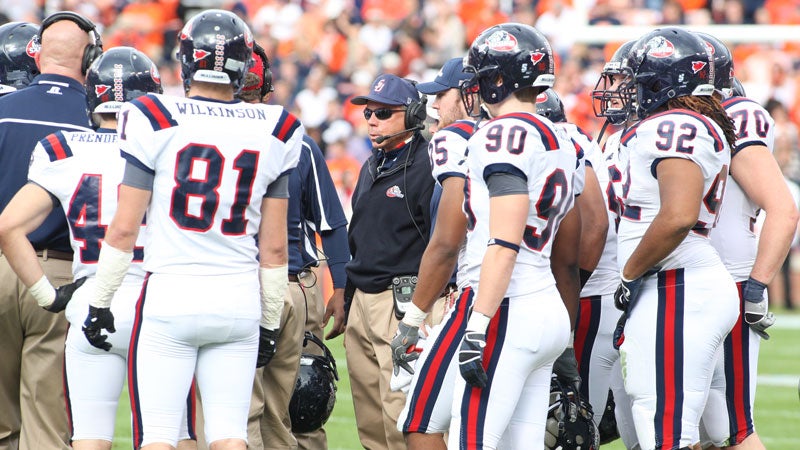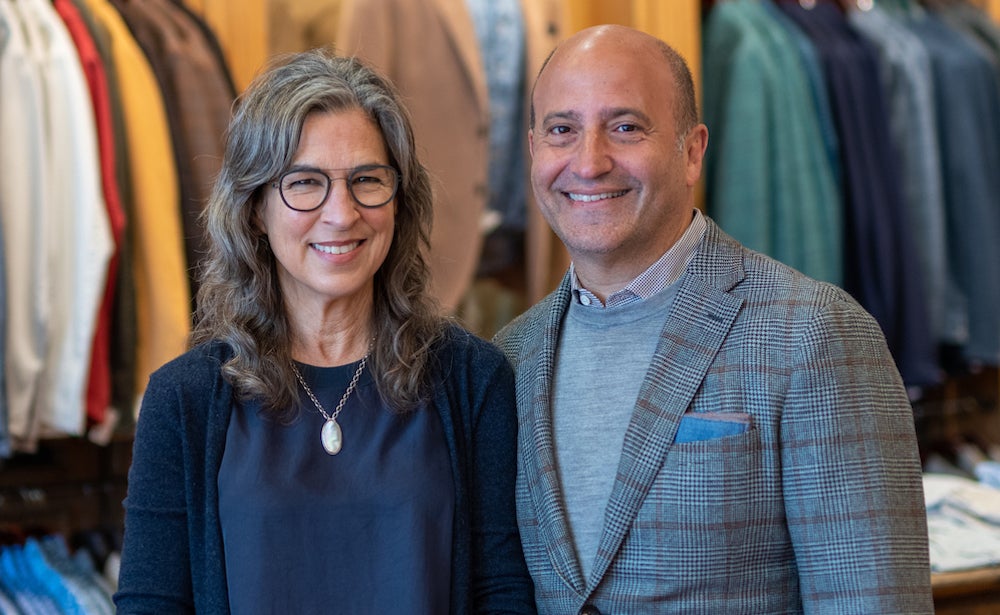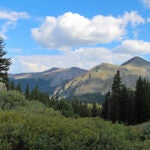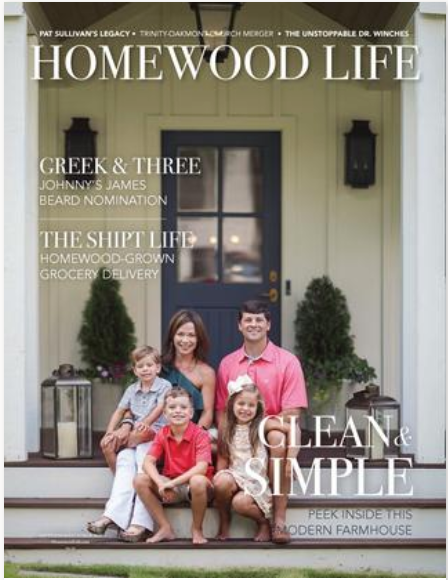In the beginning, we went inside and closed our doors, not knowing how long we would hide. We watched the trees outside change from bare branches to bright green boughs, the brilliant blue sky beckoning us back outside through one of the most temperate springs Homewood has surely ever seen.
As we finally stepped outside, with our first tentative walks around the block, we learned we could leave the house and wave to neighbors from a safe distance. And then, it seemed like all of Homewood was outside. Roads, once filled with two-ton cars and trucks, felt almost empty. And kids, no longer being ferried to baseball and gymnastics, took over those roads on their bikes, setting off on the kind of adventures most of us remember from our own childhoods. The simpler times, we told ourselves, when we’d leave home in the morning and only come home for lunch and again for dinner, when the streetlights came on. Suddenly, it was all the things we’d always wanted for our children.
Bikes lay abandoned on the banks of Griffin Brook, near the wood and steel footbridge where Forest Drive meets South Forrest. It’s late afternoon, and four boys are down in the ravine. Two are in water sandals, two in sneakers, but that doesn’t seem to matter. Everyone’s feet are wet.
The boys, ranging in ages from 7 to 9-and-three-quarters, approach a slightly older boy who’s just arrived with a net, and is picking up rocks. He settles for the minnows, but what he really wants to catch is a crawfish. The boy with the net moves upstream, his head down, his blond hair a little longer and shaggier than normal. He has the patience of someone who knows he’d normally be doing homework right now. Or rushing to karate. Or Boy Scouts.
The four boys look for fish, too. JP, Robert, Jamie and Stuart are their names. All four wear a Gizmo Gadget watch that lets their parents see where they are on a map, and is also a phone. Two have fresh buzz cuts that look like their mama owns an electric razor.
“Truth or dare?” one says to the other.
“Truth.”
“Do you have a girlfriend?”
“Dare,” he changes his mind.
“Go where the snakes are and get bitten by a copperhead.”
The boy calling the shots gets a hard stare, so they pick up sticks instead. An epic sword fight ensues. They parry, they thrust, oblivious to four more kids who cross the bridge above them, on bikes. A kid in red plaid pajamas passes over them on a scooter.
One of the boys picks up a bamboo stick.
“Hey, I’ve got a survival straw!” he says. “Do you think I can drink with it?”
The consensus is that, no, a piece of bamboo is not a filter able to turn a glorified drainage ditch into a potable water source.
“Hey, let’s try to survive outside ‘til our mom says to come in!”
It’s their first taste of freedom, and they guzzle it down, unaware that this moment in time is the one that will forever mark their before and after. For now, they are just boys in a creek, living a simpler, slower life. And they love it.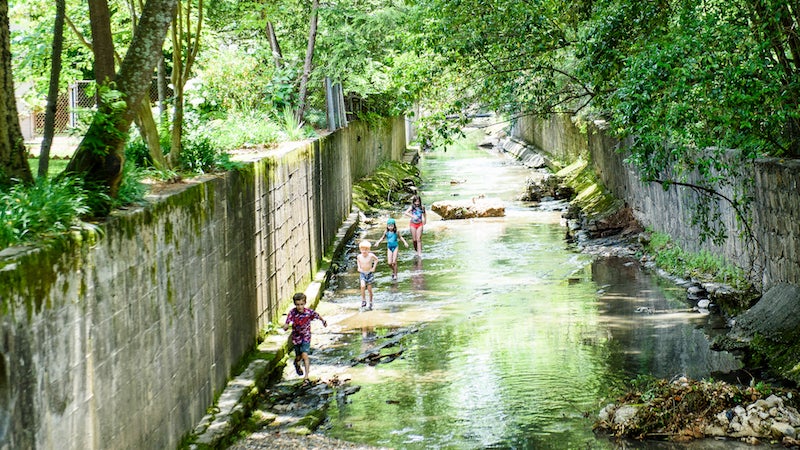
I, too, am on my bike more than usual. And every time I pass by the house of a friend of mine, her front door is always open, like an invitation to step on the porch and poke my head inside. We’ve only recently become close enough to actually spend time in each other’s homes, and I ask if her front door is always open.
She’s not sure. She wonders aloud, “Is the weather always this nice this time of year, or are we just home all the time now? I mean, usually we’re rushing around to so many things,” she says.
And we know that while the weather has been amazing, it’s the pace that has changed things.
Further up the street, Kathryn Harris and her family sit around the wrought iron table she bought off Facebook Trading last year, and finally painted right before the lockdown started.
“This table has been a lifesaver,” she says. “It’s definitely kept me sane.” Their front yard has essentially become an extension of their house. It’s where the family of six starts the day, with breakfast outside, and continues with card games and reading. The kids have even invented a game to see who can roll the tennis ball into the table’s empty umbrella hole. (It’s harder than you think.)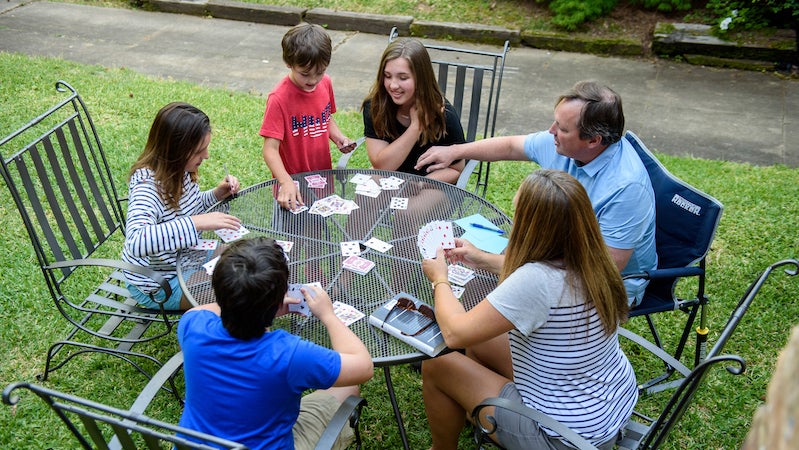
Sitting at the three-way stop of Clermont and Ardsley Place, it seems half of Homewood passes by here. A kid zooms by on a battery-powered scooter. “His sister will be by in just a second,” Kathryn says. She’s spent enough time outside to notice. “They come flying by every day, probably right about this time,” she chuckles. And right on cue a little girl on a bike whizzes past. A few minutes later their mom hurries past, apologetic that she can’t stop to chat as she tries to catch up with them.
That’s the difference between pre-coronavirus and after, Kathryn says. Before, everybody stopped at the sign and waved. Now, she says, they’re all on foot, and most everyone stops to chat.
A dad on a bike pedals by with a distinct six pack in a plastic bag hanging on the handlebars, and Kathryn’s husband, Tom, shouts out, “That’s definitely an essential run, right?”
It is SO much like that famed town where Andy Griffith spun his wholesome tales. “Living in Mayberry,” Tom says, “It’s a total luxury.” Especially at a time like this.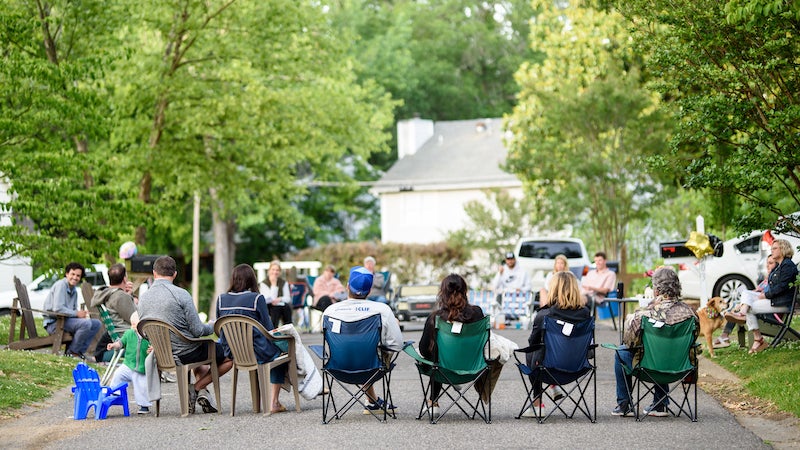
A few neighborhoods over, the sun begins to slip down, playing peek-a-boo between the branches of a giant oak tree. The Lathrop Street Saturday night church session is about to begin.
Around 30 people have pulled their camp chairs and adirondacks down to the street, and in some instances into the street. Anyone wanting to drive through would have a problem. But the street is empty. There’s no one going anywhere right now.
Birds sing their evening song and somewhere a dog barks. A preschooler rides his scooter down the middle of the street. A toddler in footfall pajamas snuggles in his father’s lap.
Jeannie Feldman says her street has always been friendly, and when social distancing began, they still gathered together, just further apart. During Holy Week, one of her neighbors, Todd Harringon, who is a minister, suggested they have an Easter service on Sunday morning, but when the weather forecast started to look bad, they decided to hold a Saturday night Easter vigil. “We all loved it so much we decided to keep the services every Saturday night until we [could] gather again at our own churches,” she says.
They talk about what they’re grateful for. Someone has a brand-new baby. Another is thankful for his kids: “They’re a lotta light in a dark time.”
Jeannie has printed the words to “I Want to Walk As a Child of the Light,” and as they sing, a little girl named Tinsley Ketcham, who is 3 and wearing a pink tutu, sashays into the middle of the street and dances, her arms waving slowly in freeform celebration.
Far off, you can hear the hum of cars and trucks on I-65 zooming past, heading somewhere fast. Probably important. But right here, right now, Tinsley twirls. And we are all just here. Here in this one, shining moment. Together. Wondering why it took a pandemic to get here. 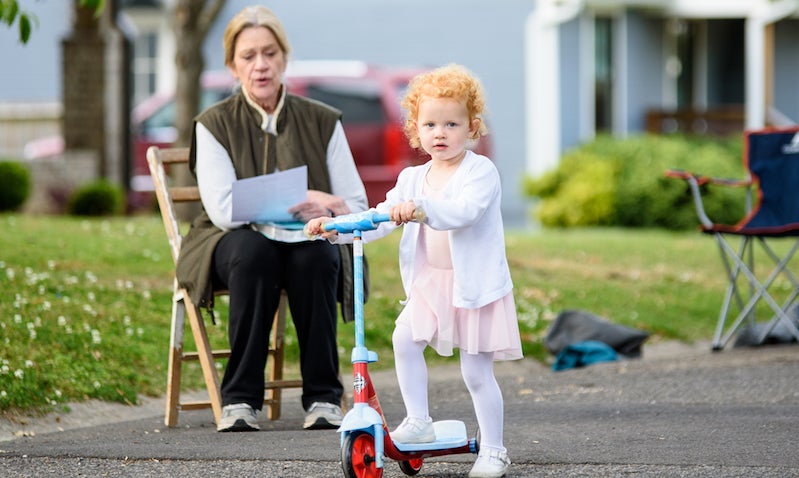
Homewood & Another Epidemic
The first people to settle what would eventually become Homewood began to arrive in the early 1800s, but it took a cholera epidemic in Birmingham for Homewood’s population to really take-off.
During the summer months of 1873, the deadly, water-borne bacterial disease broke out in Birmingham. As deaths in the Magic City rose, residents feared for their lives and fled. Some landed in Homewood and surrounding communities. Others never returned.
In the end 128 were dead from cholera, and Birmingham’s population was split in half. The city went from 4,000 people at the start of the summer of 1873, to only 2,000 by the end of the season.

